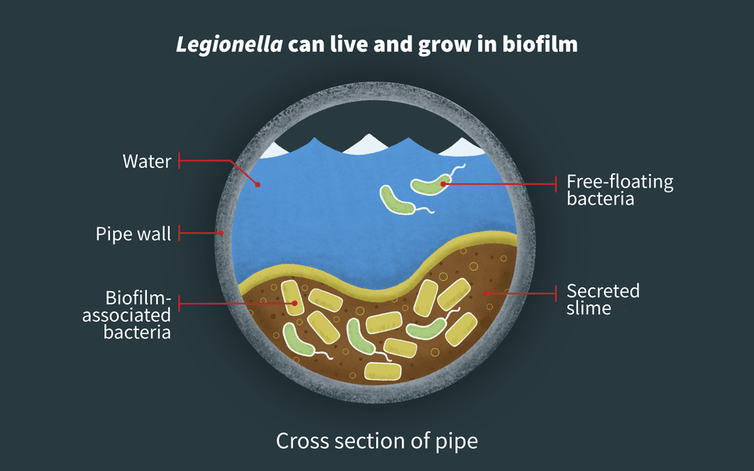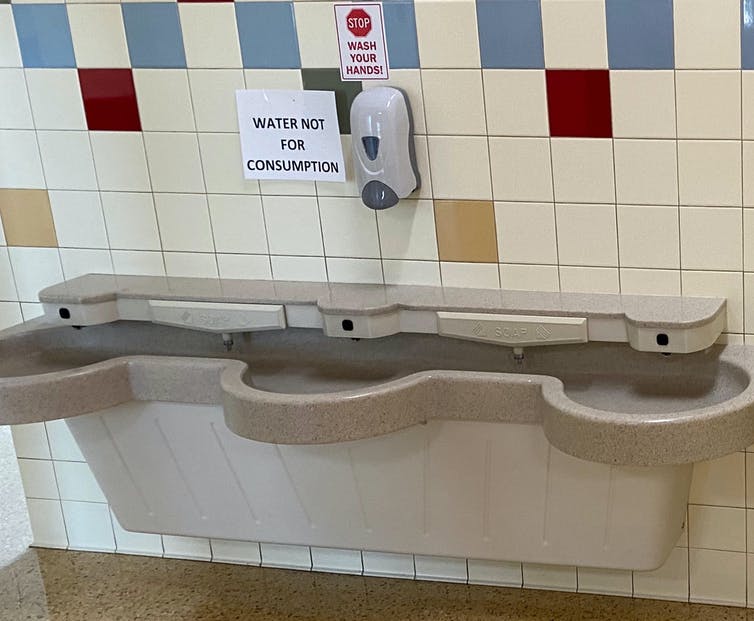As schools cautiously reopen for the fall semester, several have discovered potentially harmful bacteria in their water systems. Parents are likely concerned about what this means for their children, and other districts may be checking their own water’s safety.
As researchers who investigate water quality in buildings, we warned earlier this year that the pandemic stay-at-home orders could allow bacteria and harmful metals to accumulate in water as it sat unused in buildings’ pipes.
Some building managers looked for those problems as they reopened and found them. More than 10 schools in Ohio and Pennsylvania have reported finding harmful bacteria in their plumbing. Even the Centers for Disease Control and Prevention, the nation’s health protection agency, discovered Legionella, the bacteria that causes Legionnaires’ disease, in buildings it leases.
This presents potential health risks. For schools, it means the long checklist for maintaining a safe learning environment should include water systems. Luckily, there are simple steps that can minimize the risks.
Schools – it’s time to learn about water safety
Most schools our team interacts with do not check or flush their water pipes regularly. During school breaks, water often sits in their plumbing for days, weeks or months. This has been even longer during the pandemic.
When water use is low or has stopped, the water stagnates. That can allow organisms like Legionella to grow and harmful metals to leach into the water, potentially making it unsafe to drink or use.
Some school buildings have more than 300 water use locations, such as gym showers, water fountains and sinks in classrooms, kitchens and restrooms. Many locations go unused for long periods of time, even when school is in session. Large buildings can also have underlying problems with water temperature and movement that allow growth even without stagnation.

B. Hayes/NIST, CC BY-ND
There are no federal requirements for most schools to test their drinking water. Any testing for Legionella is voluntary, and there are no nationally regarded amounts of Legionella for when to take action, even if schools did test. Testing for other contaminants like metals varies by state and is generally not required, unless the school itself is declared a public water system.
Who is at risk?
It’s well-known that harmful organisms can grow in pipes and devices like filters, heaters and cooling towers. Finding Legionella in both cold and hot water systems is not that surprising.
We do not know if Legionella was present before the pandemic. It may have been there last summer. It may be there again next summer, too. Multiple schools have dealt with Legionella in recent years. In Ohio schools, Legionella testing seems to have been influenced by numerous pandemic-related water warnings, as well as a Legionnaires’ disease case and possible link to a janitor’s death at the same school one year earlier.
Most children are not in a high-risk group for Legionnaires’ disease, a pneumonia-like respiratory illness, but faculty, staff and children with weakened immune systems may be. It is also unknown how many children might get a less severe disease from Legionella called Pontiac fever, which has flu-like symptoms.
Infections are often linked to inhalation of aerosols when water splashes, like in showers or hot tubs, but also when flushing toilets or washing hands.
Metals like lead and copper also pose risks
Other health risks may also be building in school pipes. Exposure to lead, which can leach from metal plumbing materials, has been linked to learning disabilities and cardiovascular effects. Copper leaching from metal plumbing materials can cause acute illnesses like nausea and diarrhea.
A new study describes widespread copper contamination in an Indiana school just seven years after it was built. The only reason problems were detected was because the school decided to test – it wasn’t required to do so.
Also problematic are other metals like manganese, nickel and zinc. In schools, we’re finding levels of these metals exceeding acute drinking water exposure limits.
Plumbing isn’t necessarily safe just because it’s built to code.
Keeping students and teachers safe
Schools should assess water safety every summer before students and staff return to the buildings.
All schools should have an active water management program. These programs should address chemical and biological hazards, as well as schools’ dramatic fluctuations in use during the year.
Educating parents, students and staff about the risks is also important. While shutting down water fountains decreases touchpoints where the coronavirus could spread, students and staff should not turn to water outlets that are not approved for drinking. Sports team containers should not be filled at the shower. Hot water systems do not have to undergo rigorous testing that potable cold water systems must pass.

Andrew Whelton/Purdue University, CC BY-ND
Water management programs can identify regular preemptive actions like flushing water systems before school begins. Flushing can help bring chemical disinfectant residual to every tap to limit growth. Inexpensive hand-held disinfectant meters and thermometers can enable building operators to do their own testing. This testing could be more useful for understanding and managing water system problems than spot-testing for bacteria alone.
When flushing isn’t enough, schools may need more extreme procedures. These include chemically “shocking” the plumbing, replacing fixtures or installing building water treatment. It’s important to remember that “shocking” is sometimes just a short-term fix, as harmful organisms can return if not eradicated. A long-term commitment to healthy plumbing is needed.
The pandemic is an opportunity for schools to better understand their water systems so they can protect their students, teachers and staff. Education and preemptive action can help prevent children from getting sick, at least from the water.

































